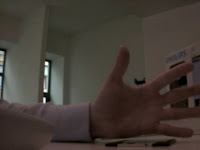It's been a while since our last update of our blog.
Last week we went to Cebit in Hannover (Germany) which was very interesting and there where plenty of (multi-)touch applications there, some in very large scale.
The last thing we did before our 'break' was place the IR ribbon around the acrylic, the acrylic arrived about one week ago, so we tested it right away with our IR ribbon.
The first results were not so promising and the result could be better, a lot better.
Our main problem is that the webcam gives a very blurry image, I'll add pictures of that so you know what i mean.
Because of the blurry image we could not get bright or clear blobs, and we could not know for sure what the problem was of the 'weak blobs', the bad lens or the IR ribbon?
So today we experimented a little with the webcam and the lens to see what could cause the blurry image.
The solution is, that you do not have to screw the lens all the way to the bottom, you need to screw it in just the right amount so that the focus is good.
I'll add a picture of the image we get now, the result is just what we expected.
Problem:

Result:

So this is the lens without IR filter!, it's not very clear to see the difference with a normal lens, but later on I'll take some some pictures So you can clearly see why you need this lens.



















































